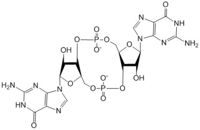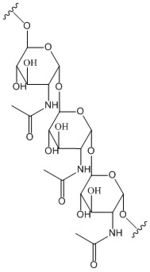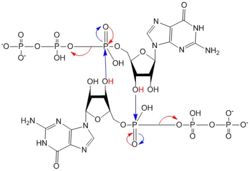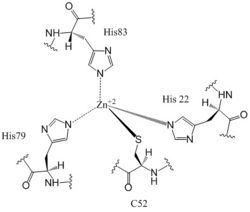Sandbox Reserved 1072
From Proteopedia
(Difference between revisions)
| Line 7: | Line 7: | ||
[[Image:Poly B-1, 6 GlcNAc.jpg |150 px|left|thumb|'''Figure 2: Poly-β-1,6-N-acetylglucosamine.''' Poly-β-1,6-N-acetylglucosamine is a carbohydrate formed downstream of C-di-GMP utilized in formation of bacterial bio-films.]] | [[Image:Poly B-1, 6 GlcNAc.jpg |150 px|left|thumb|'''Figure 2: Poly-β-1,6-N-acetylglucosamine.''' Poly-β-1,6-N-acetylglucosamine is a carbohydrate formed downstream of C-di-GMP utilized in formation of bacterial bio-films.]] | ||
Diguanylate cyclases are class 2 transferase enzymes <span class="plainlinks">[https://en.wikipedia.org/wiki/Diguanylate_cyclase (2.7.7.65)]</span> that catalyze the production of cyclic dimeric-guanosine monophosphate (c-di-GMP, Figure 1), important to <span class="plainlinks">[https://en.wikipedia.org/wiki/Signal_transduction signal transduction]</span> as a <span class="plainlinks">[https://en.wikipedia.org/wiki/Second_messenger_system second messenger]</span><sup>[1]</sup>. Signal transduction sends messages through cells to induce cellular responses, most commonly through phosphorylation or dephosphoylation of substrate molecules. <span class="plainlinks">[https://en.wikipedia.org/wiki/Escherichia_coli ''Escherechia coli (E. coli)'']</span>, a gram-negative bacterium often found in the intestines of mammals, uses diguanylate cyclase (DgcZ) in the synthesis of its <span class="plainlinks">[https://en.wikipedia.org/wiki/biofilm biofilm]</span><sup>[2]</sup>. DgcZ from ''E. coli'' acts as a catalyst, synthesizing C-di-GMP from two substrate guanosine triphosphate (GTP) molecules. C-di-GMP is a second messenger in the production of poly-β-1,6-N-acetylglucosamine (poly-GlcNAc, Figure 2), a polysaccharide required for ''E. coli'' biofilm production<sup>[2]</sup>. This biofilm allows ''E. coli'' to adhere to extracellular surfaces. Only the inactive conformation of the complete enzyme has been crystallized thus far<sup>[3]</sup>. | Diguanylate cyclases are class 2 transferase enzymes <span class="plainlinks">[https://en.wikipedia.org/wiki/Diguanylate_cyclase (2.7.7.65)]</span> that catalyze the production of cyclic dimeric-guanosine monophosphate (c-di-GMP, Figure 1), important to <span class="plainlinks">[https://en.wikipedia.org/wiki/Signal_transduction signal transduction]</span> as a <span class="plainlinks">[https://en.wikipedia.org/wiki/Second_messenger_system second messenger]</span><sup>[1]</sup>. Signal transduction sends messages through cells to induce cellular responses, most commonly through phosphorylation or dephosphoylation of substrate molecules. <span class="plainlinks">[https://en.wikipedia.org/wiki/Escherichia_coli ''Escherechia coli (E. coli)'']</span>, a gram-negative bacterium often found in the intestines of mammals, uses diguanylate cyclase (DgcZ) in the synthesis of its <span class="plainlinks">[https://en.wikipedia.org/wiki/biofilm biofilm]</span><sup>[2]</sup>. DgcZ from ''E. coli'' acts as a catalyst, synthesizing C-di-GMP from two substrate guanosine triphosphate (GTP) molecules. C-di-GMP is a second messenger in the production of poly-β-1,6-N-acetylglucosamine (poly-GlcNAc, Figure 2), a polysaccharide required for ''E. coli'' biofilm production<sup>[2]</sup>. This biofilm allows ''E. coli'' to adhere to extracellular surfaces. Only the inactive conformation of the complete enzyme has been crystallized thus far<sup>[3]</sup>. | ||
| - | [[Image:Conformation change 2 bold.png|250 px|right|thumb|'''Figure 3: Diagram of DgcZ.''' DgcZ is shown in its active (left) and inactive (right) conformations. The boxes represent the GGEEF domains of the enzyme, while the cylinders represent the alpha helices of the CZB domains, where the Zinc binding sites are located<sup>[3]</sup>. Binding Zn<sup>+2</sup> inactivates the enzyme. The red and blue sections represent the two monomers of the symmetric homodimer.]] | + | [[Image:Conformation change 2 bold.png|250 px|right|thumb|'''Figure 3: Diagram of DgcZ.''' DgcZ is shown in its active (left) and inactive (right) conformations. The boxes represent the GGEEF domains of the enzyme, while the cylinders represent the alpha helices of the CZB domains, where the Zinc binding sites are located<sup>[3]</sup>. Binding Zn<sup>+2</sup> inactivates the enzyme, by disrupting the active conformation of the GGEEF domain. The red and blue sections represent the two monomers of the symmetric homodimer.]] |
== Structural Overview == | == Structural Overview == | ||
| Line 14: | Line 14: | ||
==Catalytic GGEEF Domains== | ==Catalytic GGEEF Domains== | ||
| - | The <scene name='69/694239/Ggeef_domain_zmout_dgcz/3'>GGEEF domains</scene> of DgcZ are part of the GGDEF family of proteins that are characterized by a conserved sequence, GG[DE][DE]F<sup>[6]</sup>. The GGEEF domains contain a central five-stranded β-sheet surrounded by five α-helices (Figure 4). The GGEEF domains each possess a catalytic half-site ( | + | The <scene name='69/694239/Ggeef_domain_zmout_dgcz/3'>GGEEF domains</scene> of DgcZ are part of the GGDEF family of proteins that are characterized by a conserved sequence, GG[DE][DE]F<sup>[6]</sup>. The GGEEF domains contain a central five-stranded β-sheet surrounded by five α-helices (Figure 4). The GGEEF domains each possess a catalytic half-site (residues Gly-206, Gly-207, Glu-208, Glu-209, and Phe-210) that, when combined together in a productive conformation, form the entire <scene name='69/694239/Ggeef_domain_dgcz/6'>active site</scene>. Each half-site binds the guanine base of a single GTP molecule via hydrogen bonding to residues <scene name='69/694239/Gtp_guanine_bonds_asn_asp_dgcz/7'>Asn 173 and Asp 182</scene>. This scene depicts an inactive form of the protein because it was crystallized with zinc bound, destroying the active conformation of GGEEF domains. The ribose of each guanosine triphosphate, and subsequent product c-di-GMP riboses, are held only loosely by the enzyme, while the phosphate groups are not bound to the active site at all<sup>[3]</sup>. |
| - | The alpha phosphate is available for attack by the 3 prime hydroxyl group on another GTP. A <scene name='69/694239/Gtp_magnesium_cofactors_dgcz/3'>Magnesium ion</scene> (Mg<sup> | + | The alpha phosphate is available for attack by the 3 prime hydroxyl group on another GTP. A <scene name='69/694239/Gtp_magnesium_cofactors_dgcz/3'>Magnesium ion</scene> (Mg<sup>+2</sup>) stabilizes the negative charges on the phosphate groups. When in the inactive conformation, the C3 of the ribose on one GTP is <scene name='69/694239/Gtp_distances/2'>too far away</scene> (9-10 Angstroms) from the alpha phosphate on the other GTP to undergo cyclization. When in the productive conformation, each GTP is held in close proximity with the α-phosphate groups overlapping C3 of the ribose ring. This conformation allows the α-phospate of one GTP to react with the alcohol group attached to C3 of the ribose on the second GTP, resulting in a cyclization of the two molecules into c-di-GMP<sup>[3]</sup>. |
| - | + | ||
===Mechanism of Action=== | ===Mechanism of Action=== | ||
Revision as of 23:03, 21 April 2017
| This Sandbox is Reserved from 02/09/2015, through 05/31/2016 for use in the course "CH462: Biochemistry 2" taught by Geoffrey C. Hoops at the Butler University. This reservation includes Sandbox Reserved 1051 through Sandbox Reserved 1080. |
To get started:
More help: Help:Editing |
Diguanylate Cyclase DgcZ from Escherichia coli
| |||||||||||


![Figure 3: Diagram of DgcZ. DgcZ is shown in its active (left) and inactive (right) conformations. The boxes represent the GGEEF domains of the enzyme, while the cylinders represent the alpha helices of the CZB domains, where the Zinc binding sites are located[3]. Binding Zn+2 inactivates the enzyme, by disrupting the active conformation of the GGEEF domain. The red and blue sections represent the two monomers of the symmetric homodimer.](/wiki/images/thumb/1/10/Conformation_change_2_bold.png/250px-Conformation_change_2_bold.png)



